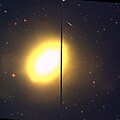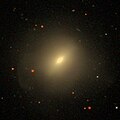| NGC 3610 | |
|---|---|
 Hubble Space Telescope image of NGC 3610, showing its disk Hubble Space Telescope image of NGC 3610, showing its disk | |
| Observation data (J2000 epoch) | |
| Constellation | Ursa Major |
| Right ascension | 11 18 25.276 |
| Declination | +58° 47′ 10.49″ |
| Redshift | 0.005694 |
| Heliocentric radial velocity | 1,732 km/s |
| Galactocentric velocity | 1,819 km/s |
| Distance | 106 Mly (32.5 Mpc) |
| Apparent magnitude (B) | 11.63 |
| Characteristics | |
| Type | E5: |
| Mass | 1.01×10 (stellar) M☉ |
| Size | 76,800 ly (23,560 pc) |
| Apparent size (V) | 1.460′ × 1.168′ (NIR) |
| Other designations | |
| NGC 3610, UGC 6319, LEDA 34566, PGC 34566 | |
NGC 3610 is an elliptical galaxy in the constellation Ursa Major. It was discovered on 8 April 1793 by German-British astronomer William Herschel. This galaxy is located at a distance of 106 million light-years (32.5 Mpc) from the Milky Way, and is receding with a galacto-centric radial velocity of 1,819 km/s.
NGC 3610 is a relatively young elliptical galaxy which has not yet lost its disk. It has a morphological classification of E5, indicating a 2:1 ratio between the major and minor axes of the elliptical profile. This is a candidate merger remnant of intermediate age, with a surviving disk of gas and dusk aligned with the major axis. This merger is estimated to have occurred 4±2.5 Gyr ago. The central part of the disk displays warping, and is significantly younger than the remainder of the galaxy.
The unusual amount of blue light emission of NGC 3610, or B–V in the UBV photometric system, suggests recent star formation. The current estimated star formation rate is 0.385±0.375 M☉·yr. There is a population of younger globular clusters orbiting the galaxy that is a likely product of the merger. The surviving population of older, metal-rich globular clusters suggests that at least one of the progenitor galaxies had a prominent bulge component.
Gallery
-
 NGC 3610 by Hubble Space Telescope
NGC 3610 by Hubble Space Telescope
-
 NGC 3610 (SDSS DR14)
NGC 3610 (SDSS DR14)
References
- ^ Skrutskie, Michael F.; et al. (1 February 2006). "The Two Micron All Sky Survey (2MASS)". The Astronomical Journal. 131 (2): 1163–1183. Bibcode:2006AJ....131.1163S. doi:10.1086/498708. ISSN 0004-6256. S2CID 18913331.
- ^ "Results for NGC 252". NASA/IPAC Extragalactic Database. Retrieved 12 February 2017.
- ^ Tully, R. Brent; et al. (2016). "Cosmicflows-3". The Astronomical Journal. 152 (2). id. 50. arXiv:1605.01765. Bibcode:2016AJ....152...50T. doi:10.3847/0004-6256/152/2/50. S2CID 250737862.
- ^ Lianou, S.; et al. (November 2019). "Dust properties and star formation of approximately a thousand local galaxies". Astronomy & Astrophysics. 631. id. A38. arXiv:1906.02712. Bibcode:2019A&A...631A..38L. doi:10.1051/0004-6361/201834553.
- "NGC 3610". SIMBAD. Centre de données astronomiques de Strasbourg. Retrieved 12 February 2017.
- ^ "A young elliptical". Hubble Space Telescope. Retrieved 16 December 2016.
- Seligman, Courtney. "NGC 3610 (= PGC 34566)". cseligman. Retrieved 12 February 2017.
- ^ Buson, L. M. (September 2010). "The mid-UV population of the nucleus and the bulk of the post-merger NGC 3610". Astronomy and Astrophysics. 519. id. A59. arXiv:1008.0922. Bibcode:2010A&A...519A..59B. doi:10.1051/0004-6361/201014429.
- ^ Howell, Justin H.; et al. (December 2004). "Probing Spectral Line Gradients beyond One Effective Radius in NGC 3610". The Astronomical Journal. 128 (6): 2749–2757. arXiv:astro-ph/0409385. Bibcode:2004AJ....128.2749H. doi:10.1086/425884.
Further reading
- Bassino, Lilia P.; Caso, Juan P. (April 2017). "The merger remnant NGC 3610 and its globular cluster system: a large-scale study". Monthly Notices of the Royal Astronomical Society. 466 (4): 4259–4271. arXiv:1701.02056. Bibcode:2017MNRAS.466.4259B. doi:10.1093/mnras/stw3390.
- Goudfrooij, Paul; et al. (June 2007). "Dynamical Evolution of Globular Cluster Systems Formed in Galaxy Mergers: Deep Hubble Space Telescope Advanced Camera for Surveys Imaging of Old and Intermediate-Age Globular Clusters in NGC 3610". The Astronomical Journal. 133 (6): 2737–2751. arXiv:astro-ph/0702467. Bibcode:2007AJ....133.2737G. doi:10.1086/516634.
- Strader, Jay; et al. (January 2004). "Revisiting the Globular Cluster System of the Merger Remnant Elliptical Galaxy NGC 3610". The Astronomical Journal. 127 (1): 295–301. arXiv:astro-ph/0310611. Bibcode:2004AJ....127..295S. doi:10.1086/380614.
- Strader, Jay; et al. (February 2003). "Keck Spectroscopy of Globular Clusters in the Elliptical Galaxy NGC 3610". The Astronomical Journal. 125 (2): 626–633. arXiv:astro-ph/0211156. Bibcode:2003AJ....125..626S. doi:10.1086/346086.
- Whitmore, Bradley C.; et al. (July 2002). "The Luminosity Functions of Old and Intermediate-Age Globular Clusters in NGC 3610". The Astronomical Journal. 124 (1): 147–157. arXiv:astro-ph/0205001. Bibcode:2002AJ....124..147W. doi:10.1086/340808.
- Fabbiano, G.; Schweizer, Francois (July 1995). "ROSAT PSPC Observations of Two Dynamically Young Elliptical Galaxies: NGC 4125 and NGC 3610". Astrophysical Journal. 447: 572. Bibcode:1995ApJ...447..572F. doi:10.1086/175900.
- Scorza, C.; Bender, R. (August 1990). "A disk in the elliptical galaxy NGC 3610". Astronomy and Astrophysics. 235: 49. Bibcode:1990A&A...235...49S.
External links
 Media related to NGC 3610 at Wikimedia Commons
Media related to NGC 3610 at Wikimedia Commons